-
Posts
58 -
Joined
-
Last visited
Content Type
Profiles
Forums
Blogs
Gallery
Events
Store
Everything posted by camelneck
-
Demir, I appreciate your opinion. Thanks! David
-
Hi, I was thinking about buying this Gallipoli star. The front side looks beautiful and is very unique. The enamel appears to be antique, but then again, I don't consider myself an expert. However, what bothers me most is the fact that there are several casting mistakes on the back side of this award. It appears to be very rough in places and there is a lot of pitting especially around the balls. A friend of mine also pointed out some pitting on and around a couple of the balls on the front side (particularly the ball on the 9 o'clock arm). Since variants of this award were made in Turkey, Austria, and Germany, I've seen many different examples of this award and I've also heard the quality of workmanship varied from excellent to fair. Thus, I'd like to hear from some fellow collectors who know a lot more about this award than I do. Is this medal a fake or is it just a victim of shoddy workmanship (especially on the reverse side)? Thanks, David aka Camelneck
-
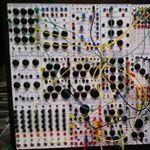
Bulgaria Medal for Merit and Order for Merit
camelneck replied to Graf's topic in Central & Eastern European States
Thanks Graf, I wasn't planning on buying this one. (I actually bought one Saturday night.) Thanks for your opinions and thanks for the excellent tips. Mr. C Neck -

Bulgaria Medal for Merit and Order for Merit
camelneck replied to Graf's topic in Central & Eastern European States
I recently found the following Order of Merit (2nd class) for sale. In the description the seller referred to it as being silver. However, I have never seen silver tarnish like this before.. This raises a question, was the Order of Merit (2nd class) suppose to be pure silver or was it silver-plated bronze (or brass)? If the Order of Merit (2nd class) was made of pure silver then logic dictates that the medal pictured below is either 1) a fake or 2) the silver has somehow developed a very unusual bronze-like patina. On the other hand, it the Order of Merit (2nd class) was made of silver-plated brass or bronze as opposed to being true silver, then there a 3rd possibility comes into play: 3) this was a silver-plated bronze medal that has lost all of its silver. Well, enough of my logic, I would like to hear from the experts as to why the medal below doesn't look like Igor's Order of Merit (above). They both suppose to be silver, but only Igor's looks like a silver medal. --------- Igor, Those are very nice awards. I especially like your Order of Merit. Thanks for posting! -

Bulgaria Medal for Merit and Order for Merit
camelneck replied to Graf's topic in Central & Eastern European States
-

Bulgaria Bulgarian medals and ribbon bars
camelneck replied to Deruelle's topic in Central & Eastern European States
In addition to a rosette, didn't all the 4th class awards have gold crowns and swords? (At least mine has a gold crown and gold swords.) On the other hand, don't the 5th class awards have silver swords and silver crowns (provided they come with a crown)? I think the same thing was true about the Romanian Order of the Crown? My Officer's Class has a Rosette on the ribbon and gold gilt on the crown and swords. However, I believe the Knight's Class has no Rosette and their swords and crown are silver instead of gold? ---------- Elaborating on what Hypnos was saying, there were actually 36 possible variations of the Medal of Merit although I don't know if all 36 possible types were awarded. Each Medal of Merit falls into 6 basic categories: gold, silver, bronze, gold with crown, silver with crown, and bronze with crown. For each of these 6 categories, there are 6 sub-categories based upon who or what is on the front side of the medal: 1) Knjaz (Prince) Alexander; 2) Knjaz Ferdinand; 3) Tsar Ferdinand I, 4) Tsar Boris III, 5) Tsar Boriss III (with "A" missing from Bulgaria); and 6) a regent coat of arms instead of a prince or king. Technically speaking, there was a 37th variation which was awarded to Stefan Stambolov which was a gold medal with crown and diamonds. (If one was to count wartime awards that were awarded on the bravery ribbon, there were over 50 variations of this award.) And I used to think that the Bavarian MVK held the record for the most variations ... David -

Bulgaria Bulgarian Order for Bravery 1941
camelneck replied to Graf's topic in Central & Eastern European States
-
I know that German Panzer Tank Ace Michael Wittmann, who had more tank kills than anyone in WW2, was awarded a Bulgarian Soldiers Cross for Bravery in the summer of 1941 when he was a Sergeant on the Russian Front. By the end of 1941, he became an officer who rose to the rank of captain when he was killed in action in August 1944. Wittmann's conquests on the was fighting the British on the Western Front and in the span of 15 minutes his Tiger Tank single-handedly destroyed 15 British tanks, 14 personnel carriers, and 2 anti-tank gus. QUESTIONS: 1) Does anyone know what class or classes of the soldier's cross Wittman was awarded (at the very least do you know whether it was a gold or silver cross)? I've heard he earned a gold cross, but did he also earn a silver cross? 2) Were these awards rank-based, merit-based, or a bit of both and were there any specific rules on how they were awarded. I have heard that the silver crosses (class 4 and class 3) were given to enlisted men and that the gold crosses (classes 1 & 2) were strictly reserved for NCOs. If this is so, what rule or rules governed whether an enlisted man received a class 3 or class 4 award and whether a NCO received a class 2 or class 1 award? For example, were first time (enlisted men) recipients awarded class 4 awards while those who earned a repeat award given a class 3 cross? Or were the 4 classes totally merit-based meaning that a typical act of bravery earned the class 4 cross while a slightly more courageous act earned the class 3 cross. In such a system, a recipient of a class 1 award would receive the award only if he had demonstrated a truly remarkable act of bravery. MORE ON WITTMANN: In the event anybody is unfamiliar with Captain Michael Wittmann, his total number of victories (or kills) were 141 tanks and 132 anti-tank guns. He took command of his first Tiger tank in 1943 and immediately became a war hero. On July 5, 1943, which marked his first day of action in a Tiger tank, Wittmann destroyed 13 Soviet T-34 tanks and 2 anti-tank guns and saved another platoon that had run into trouble. Between July 5 and July 17, Wittmann's Tiger destroyed 30 Soviet tanks along with 28 anti-tank guns. Wittmann is best known for his ambush of elements of the British 7th Armoured Division, during the Battle of Villers-Bocage on 13 June 1944. While in command of a Tiger I tank, he destroyed 14 tanks, 15 personnel carriers, and 2 anti-tank guns within the space of fifteen minutes. As a result of this enormous achievement, on June 22, 1944 he received "swords" to go along with the Oak Leaves he had previously earned for his Knight's Cross. They were presented to him by Hitler himself at the Wolf's Lair. Thanks for all the information. You are one lucky guy! David
-

Bulgaria Bulgarian Order for Bravery 1941
camelneck replied to Graf's topic in Central & Eastern European States
New World, you have some beautiful Bulgarian Awards! One of these days I would love to find an Order of Bravery 3rd class with crown (that is as nice as yours) to go with my 1915 Order of Bravery 4th Class. The highlight of my Bulgarian collection is the Order of Military Merit Officer's Class complete with gold crown and ribbon rosette. (I just love that crown.) Unfortunately, it isn't one with war decorations. I also have 1 silver and 2 gold soldier's crosses (1915 versions) and a bronze Royal Medal of Merit with crown (Tsar Ferdinand version). I'm presently looking for a silver Royal Medal of Merit with Crown as well as the silver Order of Merit. I hope to find them in the next week or two So far all my Bulgarian awards are WW1 era. Is your primary focus WW2 or do you have just as many WW1 awards? Nice photos of Gen Stoychev. Thanks for sharing. I found the very first photo to be most interesting. The officer that is directly to the left of Gen Stoychev (farthest right in the photo) reminds me a little bit of General Burkhalter from Hogan's Heroes! -
Are their fakes of the Soldier's Cross of Bravery going around? Here is why I ask, I currently have 3 Soldiers crosses (1 silver and 2 gold) so I'm familiar with what they look like. However, not long ago, I saw a silver one for sale. I'm 99% sure it was original, but I noticed one thing that introduced 1% of doubt. There was a rough spot (slight ridge) on the side of one of the cross arms. It was as if the maker didn't do his best work when he was filing the edges of that particular cross arm. I've always heard that unfiled ridges on the sides of certain medals (especially in the case of an Iron Cross) could be an indicator that a medal might be fake. (Evidently, many of the people who make fakes don't put the time and effort into filing these ridges down.) But then again, even the best jewelers can occasionally allow a slight flaw or defect to pass. As I said, I'm pretty sure the medal was legitimate, and unfortunately, I don't have a photo I can post. However, it made me wonder if there were a lot of fake soldier's crosses out there. Thanks!
-
Most every soldier's cross that I've seen has the date 1915 on the front and 1879 on the reverse. However, like this unusual cross, I have seen a couple of soldier's crosses that have no date on the front and 1879 on the reverse. Were all crosses with no date on the front, issued prior to 1915 or were some of these crosses with dateless fronts issued after WW1? Does anyone have a close-up photo of your 1941 Soldier's Cross? I would love to see it. Does it have the date 1941 on the front instead of 1915? Thanks. David
-
I'm also positive that this wasn't a 4th class award without enamel. I assume new world was talking about the cross arms when he used the word "rays". If so, I was going to mention this also. The cross arms could not be smooth. Some kind of pattern of raised lines would have had to been etched into them in order to provide the texture underneath the red enamel that all 4th class medals possess. Since the cross consist of multiple parts, one would expect these raised lines to be present on the arms of the cross prior to assembly. it would only make sense. However, no such raised lines exist. Thus, if someone applied red enamel to the arms of this cross, it would look like clear glass that was free of any texture. Personally, I find the center medallion (both sides) to be most interesting. In this case, we actually find a pattern of raised lines that have been etched into the medal in the exact location where you would find the red enamel in the center of a 4th class award. However, this particular pattern consists of raised "radial lines" that originate from the center of the medallion in a radial (spoke-like) fashion. While there are raised lines etched into the medallion of a 4th class medal, these lines are vertical lines (that are parallel to each other) as opposed to non-intersecting radial lines. This alone is definitive proof that this medal was designed to be different than both the soldier's cross and the Order of Bravery 4th Class.
-
I recently saw a silver Waldeck Merit Medal for sale that looks identical to the Golden Waldeck Merit Medal shown in the previous post by eitze (minus the swords). (I'm assuming the reverse side of eitze's medal contains the words "Fur Verdienste" and nothing else.) Despite the lack of swords, the silver medal that I saw was suspended on the same white "war ribbon" as the one used for both the Waldeck Silver Merit Medal with swords and the Waldeck Golden Merit Medal with swords (see Eitze's photos). It was my understanding that both silver and golden "Waldeck merit medals without swords", were suppose to be suspended by the peacetime ribbon which looks identical to the ribbon used in conjunction with the Princely Reuss Silver Medal of Merit. (This ribbon is yellow-orange in color with red and black stripes.). I've looked everywhere, but I cannot find a silver Waldeck Medal that looks like the one that I just described. Every photo that I have seen of the Waldeck Silver Merit Medal has the initials "G V" with a crown on top of the initials. According to Volume 7 of O'Connors "Aviation Awards and the Men Who Earned Them", Georg Viktor (GV) was the reigning prince of Waldeck when the silver merit medal were first issued. However, when the golden merit medal was issued a few years later, Friedrich was on the thrown. This explains why the "GV" initials on the silver merit medal were replaced by a golden 8-ray star with the cross Moline of Pyrmont in the center. As for the silver medal that I saw, has anyone else seen a silver merit medal that has an 8-ray star with a cross Moline in its center on its obverse side as opposed to the letters "GV"? David
-

Austria-Hungary Austrian Bravery Medals - Tapferkeitmedaille
camelneck replied to Tim B's topic in Austro-Hungarian Empire
Thanks Elmar. -

Austria-Hungary Austrian Bravery Medals - Tapferkeitmedaille
camelneck replied to Tim B's topic in Austro-Hungarian Empire
Before I tell my story, let me ask my question. Do all bronze FJ bravery medals have an engraver's mark underneath the bust of Franz Joseph? I recently bought a medal that was sold as "a small (30mm) silver Franz Joseph bravery medal". Even before I bought it, I thought it looked suspicious for two reasons: 1) It was almost totally black in appearance with the tinniest bit of gray or silver peeking through the black tarnish. 2) There was no maker's mark, such as "Tautenhayn" underneath Franz Joseph's shoulders. Although I had my doubts that it was a silver medal, it showed little signs of wear. I also got a really good deal on it so I bought it out of curiousity more than anything else. The next day I dipped the tip of a Q-tip in liquid silver cleaner and applied it to a tiny area on the edge of the medal. The silver cleaner had no effect and it usually works really fast. I began to think it was made of Kriegsmetall because I never saw bronze turn black with a hint of silver. I then applied a bit of brass/bronze cleaner to a tiny spot on the edge. The brass cleaner immediately cut through the tarnish exposing a beautiful golden/copper color. Since I only paid a few dollars for this medal, I decided I would clean the entire medal. I don't think I have ever seen or cleaned a medal with this much tarnish on it. However, it cleaned up to be one of the most beautiful medals I have ever seen with a mirror-like finish, yet it still has a very antique-vintage look to it. It is now distinctive for 3 reasons: 1) The medal has a pinkish-bronze look to it, but the ENTIRE BUST OF Franz Joseph looks as if it WERE PLATED IN GOLD! There is this yellow-gold bust on top of this slightly reddish bronze medal--GORGEOUS! Maybe it has something to do with the way I cleaned it, but I'm not going to touch it anymore because I'm very happy with the way it looks right now! 2) There was no maker's mark, such as "Tautenhayn" underneath the shoulders of the FJ bust. 3) The bust details, such as the hair, the beard, the "neck award", and the shoulder's of the bust seem to be slightly different from those in the photos above as well as most other bravery medals. However, the details are way too professional for it to be a cheap fake. Should all Austrian bravery medals have the name of the engraver? Any comments? I'll try to post a photo in the next few days. My camera won't capture the fine details of this medal. UPDATE: I just found a 40mm gold Franz Joseph medal on emedals.com that has the same bust details as my 30mm bronze medal. This medal does not have an engraver's mark either (at least not underneath the shoulders). This medal is listed as a private-purchase 1920's Austrian Gold Bravery medal. Here is the link to the auction with photos: https://www.emedals.com/europe/austria-imperial/medals/bravery-medals/a-1920-austrian-golden-bravery-medal-eu7817 -
Hi Solomon, Nice crosses. You have the copper version of the 15 yr Prussian LS Cross. I happen to have the gold-plated white metal version of this same award. I think? When I first started shopping for this award, I remember I would see what looked like at least 2 different versions of this award: a gold-plated version and a darker, copper version that had a bit of a red tint. (The amount of red would vary from medal to medal.) I ended up buying 2 of the gold-plated versions--one with a couple of small scratches and one that was nearly perfect. Recently, I was researching various long service medals on the website www.ehrenzeichen-orden.de. Under the Prussian 15yr LS cross, they had a photo of the copper cross and a bit of information about it. However, they didn't mention anything about the gold-plated version. I then started reading about the various Hesse long service medals in order to figure out whether Hesse and Prussia used the same medals (just different ribbons). I then pulled up the Hesse 15yr Long Service cross and I saw a photo of the gold-plated version of the cross and it looked like my 2 crosses. It said this cross was made of gold-plated white metal. Except for the color of the metal, this cross looked identical to the picture of the Prussian copper cross. All of this leads to the big question? Since the crosses look identical, why is there a cross made of copper and why is there a cross made of gold-plated white metal. I can think of 2 possible answers: 1) The copper crosses were issued early in the war and the gold-plated white metal crosses were issued as the war progressed and copper became more scarce. (As far as I know, white metal was only used for medals made in 1916 or afterwards so this makes sense.) or 2) Prussia made their 15yr LS crosses out of copper and Hesse made their 15yr LS crosses out of gold-plated white metal. Except for the color, the medals look identical. Furthermore, I always thought that the Hesse and Prussia Long Service awards (9yr, 12yr, and 15yr) used the exact same medal. (Thus, it was the ribbon that made it a Prussian or a Hessen award ) If all Prussian medals were copper and all Hessen medals were gold-plated white metal, this would be an exception to that rule. Any comments? Below is a photo of the 15yr white metal version.
-
Thanks for the information, Dave. About 2 months ago, I compared photos of a Hessen and a Prussian 12yr Long Service Medal and I was able to notice some very slight differences in the crown. However, the differences were so slight, that I thought it might be due to different manufacturers or even wear and tear. About 2 weeks ago I compared photos of a Hessen 9yr and a Prussian 9yr and I couldn't tell any differences in the crown. But maybe, the Hessen medal was actually a Prussian medal on the wrong ribbon or vice versa. According to the website Ehrenzeichen Orden, there were 3 different versions of the Prussian 15 yr cross based upon their composition: 1) copper (perhaps they meant gold-plated copper), 2) gold-plated white metal (Weißmetall vergoldet), and 3) tombac bronze. This explains why many of the Prussian 15 yr LS crosses have a reddish (copper/bronze) appearance and why others have a golden appearance. (Both of mine are made are made of gold-plated white metal and they can be scratched very easily.) As of last night, this thread has taken on new meaning. The ribbon loop on one of my 12-yr Prussian medals broke off from the medal. I decided to take it to a jeweler and see if he could reattach it. Although all of the information I can find regarding the Prussian 12-yr medals says it is made of bronze, the jeweler thinks that the broken medal is only bronze-plated. If it is pure bronze he can fix it. If it is a bronze-plating, he is afraid the heat will damage the plating.. Thus, I'm in a bit of a dilemma. If it wasn't a piece of history I'd just tell him to put the torch to it and see what happens. Does anybody have any advice or possibly some other ideas on how it might be fixed? s if there are bronze-plated 12 yr medals please let me know..
-

Bulgaria Bulgarian Order of Military Merit
camelneck replied to Alex K's topic in Central & Eastern European States
This is one of the most complete and informative threads that I have seen in some time. I wanted to send a special thanks to Carol I and 922F for all of the wonderful information that they provided, as well as Alex K for the great question. I'm also grateful for the info regarding why the bravery ribbon was sometimes used. I have a screen capture of a Bulgarian Ribbon Photo Gallery that I made from a webpage off the Internet, which showed both the Bravery Ribbon and the black-wh-yellow ribbon as valid ribbons for the Order of Military Merit during the Kingdom of Bulgaria era. There was a footnote stating that the bravery medal could only be awarded to classes 4 thru 6, but it didn't provide an explanation. I now see why I've only seen it on the 6th class silver crosses. I currently have an Officer's Class Order of Military Merit with crown, swords, original case, and ribbon rosette. I also have gold and silver Bulgarian Soldier's Crosses for Bravery. A 4th class bravery medal (or better) is on my future shopping list. -
Thanks, Claudius. Once I have the Waldeck medal I'll have all my EK2 Equivalents for enlisted men. In addition to wartime merit and bravery awards, which are my favorite, I've also started expanding my Long Service (Military Dienstauszeichnung) collection. I had originally stopped at 9,12,15, & 25yr for Prussia and 9,12,15,& 24yr for Bavaria. But I recently added 10 more medals: the 9,12, & 15yr for Hesse (Prussia on another ribbon), 9,12, & 15yr for Wurttemberg, 9, 12, & 15yr for Baden. and 9yr for Saxony. I just need the 12yr & 15yr Saxony awards to complete all those. Other long service awards, such as Saxe-Weimar and Mecklenburg, are much more difficult to find, but I'm sure I'll eventually start on those. :). I like to go for the easy ones first! David
-
I had been looking for a Saxe Meiningen KVK for almost a year and had no luck. Then last month I bought the zinc one (pictured in earlier posts) from ebay Germany. I still had hopes of some day finding a nice bronze S-M KVK. I hadn't had my zinc cross for 2 weeks, and this morning, I stumbled on a nice bronze one on USA ebay with only about 4 hours left to go in the auction.. Can you believe I searched for over a year with no luck at all and then I find 2 of them within 2 weeks?. Although this happened a whole lot sooner than I ever thought, I decided to enter a last minute bid on this auction. Well, I got lucky again and won this auction with a 10 cent margin! So I now have a nice bronze SM KVK to go along with my zinc one. ::) (I also have the bronze medal version of this award.) Now I'm going to focus all of my effort on a silver Waldeck Merit Medal with swords! Here is a couple of photos of the latest conquest courtesy of ebay. I hope to have it in 2 to 3 weeks.
-
Hi Claudius, Thanks for the nice comments. Below is a photo of the reverse side, which I like even better than the front. As far as ribbons go, I currently have 2 combatant's style ribbons on order. One is approximately 36mm wide and the other is only 30mm wide. (BTW, this is one of my favorite ribbons. I really like the color scheme.) I agree with you. The addition of a ribbon will definitely add some much needed color to this award. I also have the SM Honor Medal for Merit in War, which is the enlisted man's version of the SMK. (It is already on a combatant's ribbon.) My SMHM is made of bronze. IMO, the early bronze medals are more attractive than the zinc ones. (I once saw a black SMHM for sale and it was supposedly made of iron.) One of these days I would love to find a nice specimen of the SMK in bronze. However, if I do find one in bronze, I still plan to hold onto this zinc SMK since the zinc ones are more scarce. Cheers, David
-
Did anybody ever give an official answer to Alan's original question?? Other than matching the medal with a different colored ribbon, did Hesse and Prussia use the exact same medals for the 9yr, 12yr, and 15yr Long Service Awards. I've compared photos of Hesse and Prussian Long Service Awards and I can't seem to tell a difference between them.


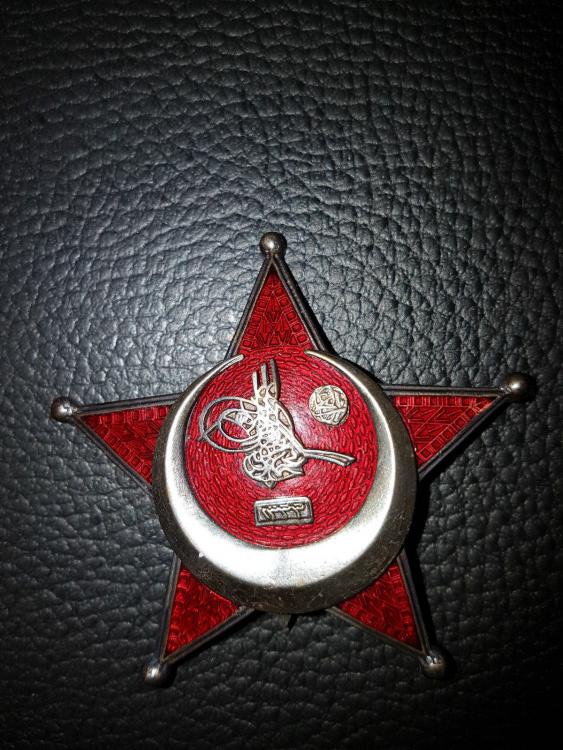
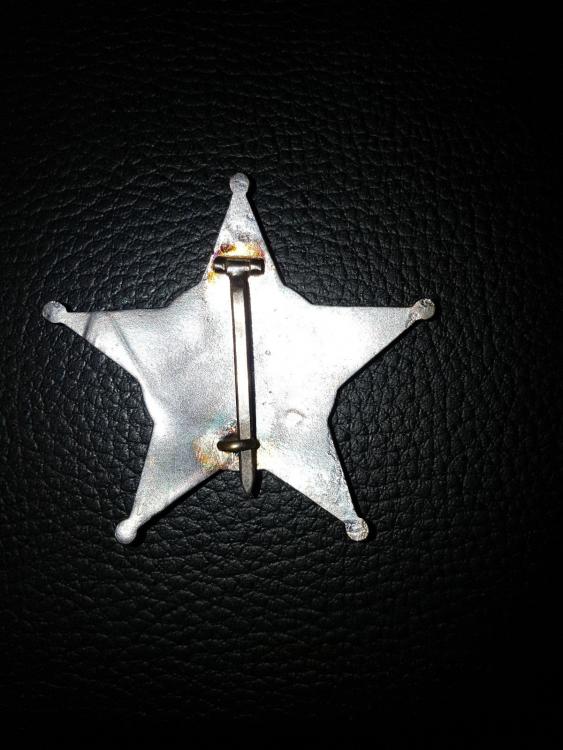
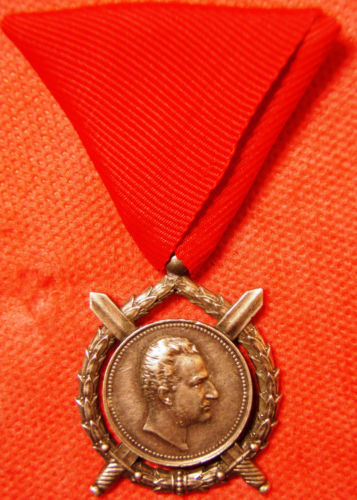
.jpg.da02ecec050bd6257f9f4da112a20332.jpg)
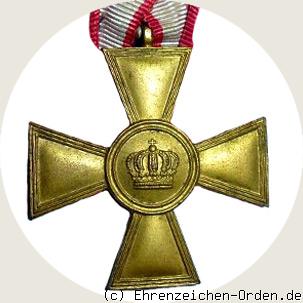

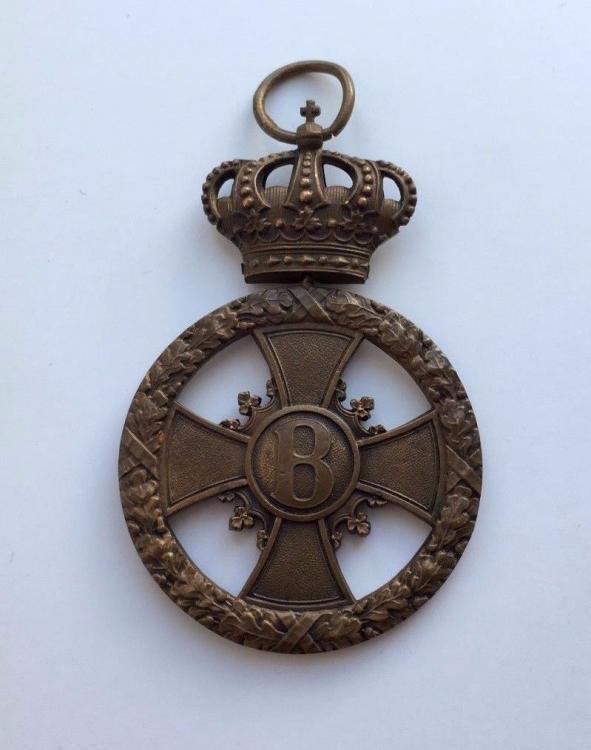

R.jpg.4dad6cee9dd1cc93c977653f31983c5f.jpg)